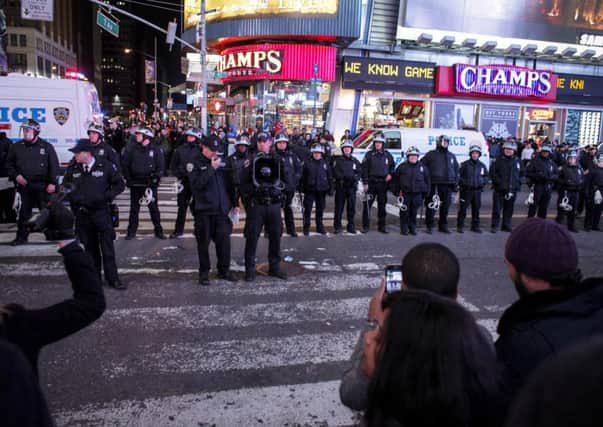US protests mount over black men killed by police


The wave of protests began after officer Daniel Pantaleo was cleared over his role in a confrontation that ended in the death of Eric Garner. A bystander caught the incident on a video that has been viewed repeatedly online.
The reaction echoes the outrage after a grand jury declined to indict a white policeman for killing an unarmed black teenager in Ferguson, Missouri. US attorney general Eric Holder has mounted a civil rights review of that shooting and promised a full investigation of the New York case.
Advertisement
Hide AdAdvertisement
Hide AdThursday’s protests began during the evening rush hour, with demonstrators weaving between cars and lorries and bringing traffic on city streets to a near-standstill.
The marches picked up recruits along the way, shifted direction, splintered and regrouped, but remained relatively peaceful for a second night.
Tensions rose as at least 3,000 protesters converged in Times Square about 11pm local time on Thursday. Blocking the major intersection of 42nd Street and Seventh Avenue, they chanted at police, “Who do you protect?” Hundreds of officers lined up to push protesters on to pavements. Dozens were detained, although police declined to give precise numbers.
Earlier, protesters in lower Manhattan staged sporadic sit-ins at intersections before police in riot gear warned them to move on or face arrest. Most complied.
Sharon Gordon, 52, from New Jersey, said she hoped politicians would take heed. “There’s been a confluence of social media and outrage,” she said. “I do believe for the first time we’re about to make a change.”
Waves of marchers blocked traffic on two bridges between Manhattan and Brooklyn, then converged on the Staten Island ferry terminal at Manhattan’s southern tip. The main group headed west and temporarily shut the West Side Highway, resulting in at least a handful of arrests, before turning north toward Times Square.
A smaller crowd confronted police with taunts. Chesray Dolpha, 31, shouted at the officers: “We are not violent. We are not touching you. What are you doing with that baton, brother?” The police did not reply.
Hundreds demonstrated in Washington DC, chanting, “No justice, no peace, no racist police,” as they passed the justice department, neared the White House and headed to the Washington Monument. Protesters staged a “die-in” there, sprawling on the road to block traffic.
Advertisement
Hide AdAdvertisement
Hide AdProtesters also blocked traffic on interstate 35W in Minneapolis and on Lake Shore Drive in Chicago. Other demonstrations prompted officials to close two Bay Area Rapid Transit stops in Oakland, California, and re-route bus traffic around part of San Francisco’s Market Street.
Unlike the shooting of 18-year-old Michael Brown on 9 August in Missouri, Mr Garner’s encounter with New York police was captured on video by a bystander’s mobile phone. Mr Garner was being arrested for allegedly selling cigarettes illegally in Staten Island in July.
The video showed Mr Pantaleo wrapping his arm around Mr Garner’s throat and wrestling him to the ground, as three other officers help to subdue him. Mr Garner repeatedly gasped, “I can’t breathe” – a phrase protesters have taken up as a rallying cry.
Mr Pantaleo could still face disciplinary action from an internal police investigation, his lawyer said. That investigation is likely to focus on whether he used a chokehold, which is banned by police regulations. Mr Pantaleo told the grand jury he had used a proper takedown technique and never put pressure on Mr Garner’s neck, according to his lawyer, Stuart London.
The city’s medical examiner has said Mr Garner died after his neck and chest were compressed. His asthma and the fact he was overweight were given as contributory factors.
Although chokeholds are officially prohibited, the police patrol guide is vague about whether they are permitted under certain circumstances, Maria Haberfeld, head of the law and criminal justice department at New York’s John Jay College, said. That grey area, she said, may have influenced the grand jury and could be a factor in the departmental probe into Mr Pantaleo’s conduct.